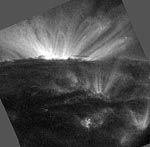
| Bad Astronomy |
|
|
|
BA Blog
|
|
Q & BA
|
|
Bulletin Board
|
| Media |
|
|
|
Bitesize Astronomy
|
|
Bad Astro Store
|
|
Mad Science
|
|
Fun Stuff
|
| Site Info |
|
|
|
Links
|
| RELATED SITES |
| - Universe Today |
| - APOD |
| - The Nine Planets |
| - Mystery Investigators |
| - Slacker Astronomy |
| - Skepticality |
Buy My Stuff

Keep Bad Astronomy close to your heart, and help make me
filthy rich. Hey, it's either this or one of those really
irritating PayPal donation buttons here.
The Prodigious Sun
Week of May 4, 1998We take so much for granted. Every second of every day, the Sun puts out more energy than every means of energy production the human race has ever designed. Yet how much does the average person really know about the Sun? There are lots of surprising facts about the Sun, and sometimes it takes new technology to bring them home.
 In April of 1998, NASA launched a satellite called
Transition Region and Coronal Explorer, or TRACE, into Earth orbit aboard
the new launch vehicle named Pegasus. TRACE looks at the region of the
Sun between the "surface" that we see, called the photosphere,
and the corona, the wispy ethereal atmosphere of the Sun seen in every
solar eclipse picture. Not much is known about the corona, except that
it is exceptionally hot (the temperature is in the millions of degrees,
not that
it would burn you!) and it is dominated
by the magnetic field of the Sun. The image above shows the surface
of the Sun by tracing the light emitted by a particular flavor of iron.
In it you can see the relatively dark surface of the Sun, together with
giant loops of material constrained by the Sun's mighty magnetic field.
In April of 1998, NASA launched a satellite called
Transition Region and Coronal Explorer, or TRACE, into Earth orbit aboard
the new launch vehicle named Pegasus. TRACE looks at the region of the
Sun between the "surface" that we see, called the photosphere,
and the corona, the wispy ethereal atmosphere of the Sun seen in every
solar eclipse picture. Not much is known about the corona, except that
it is exceptionally hot (the temperature is in the millions of degrees,
not that
it would burn you!) and it is dominated
by the magnetic field of the Sun. The image above shows the surface
of the Sun by tracing the light emitted by a particular flavor of iron.
In it you can see the relatively dark surface of the Sun, together with
giant loops of material constrained by the Sun's mighty magnetic field.
The Sun frequently erupts in titanic explosions of energy, bursts so large that their effects can be felt here on Earth about 150 million kilometers away. Satellites can be hurt, aurorae are generated and sometimes they can even cause widespread blackouts by overloading power grids! Studying the Sun is a very important occupation, and I am glad we have a lot of smart people doing it.
|
|
| THE PANTRY: ARCHIVE OF BITESIZE SNACKS |
|
|
| Subscribe to the Bad Astronomy Newsletter! |
| Talk about Bad Astronomy on the BA Bulletin Board! |